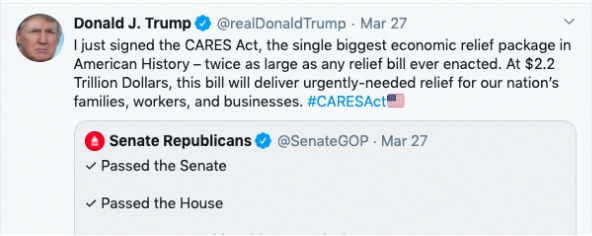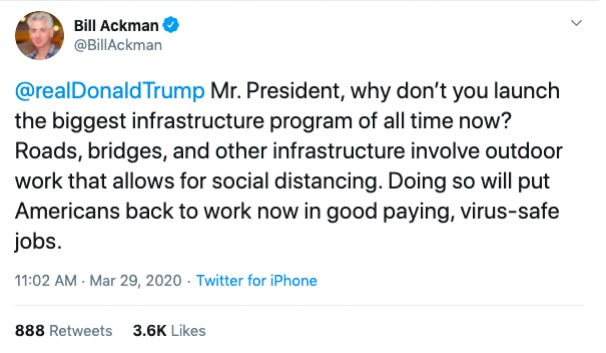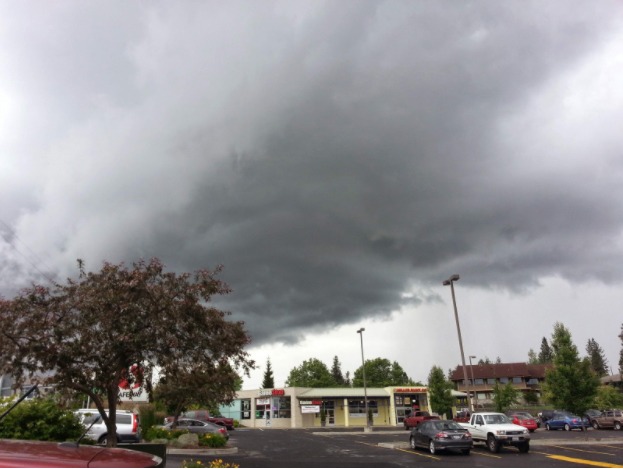It’s Time to Get Serious about Infrastructure

The Yuge CARES Act Stimulus Bill earmarks almost $500 Billion for large corporations.
Just like that, the most expensive stimulus measure ever taken was signed into action. As individuals and small businesses wait for the crumbs, corporate lobbyists are lined up at the $2.2 Trillion feed trough to help “save their industries”.
It’s hard to imagine how another round of huge corporate bailouts will jumpstart the economy. If we’re to recover from this, it will start with rebuilding durable national assets and creating new jobs doing it. That’s not going to happen by bailing out the airline industry. It’s going to happen at the local level with smart infrastructure investment.

At least one billionaire hedge fund manager agrees.
Often taken for granted, physical infrastructure assets are crucial for a well-functioning society.
As this crisis has unfolded over the past couple weeks, it’s made me notice just how valuable local infrastructure is and the role that local governments play in making sure it functions. Municipalities provide the services, resources and infrastructure to keep communities safe. Uninterrupted water, sanitation, and emergency services are nothing short of modern miracles.
They are also an afterthought for federal funds, even as cities risk going broke.On the heels of this pandemic “shock”, it’s pretty obvious the U.S. needs to get serious about better preparing our cities for imminent surprises. Whether it’s a virus or Hurricane Katrina, the U.S. ought to get familiar with future-proofing: the process of anticipating the future through the development and application of methods that can minimize the stresses of future events.

More storms are coming: Whether it’s a novel virus or a hurricane, the U.S. needs to take the concept of “future-proofing” very seriously.
And what better way to do this than to begin investing immediately in the improvement of dilapidated and outdated U.S. infrastructure assets. The back-and-forth about infrastructure has been going on for so long in our nation’s capital that it has become a running joke. What’s not funny though is reading a D+ on America’s Infrastructure Report Card.
The group that puts out this Infrastructure Report Card report is the American Society of Civil Engineers. They estimate that the U.S. is on track to invest only half of what is needed in infrastructure over the next decade.
Even in normal times infrastructure investment should be a key component of any fiscal stimulus plan. It’s reported that a $250 billion annual investment in infrastructure could create 3 million new jobs in the first year alone. A package stretched out over ten years not only provides immediate economic stimulus, but also a solid foundation for further economic development down the road. A comprehensive, equitable, and climate-smart package that improves job quality and fixes broken assets is a no-brainer.
Treasury yields are below 1% making federal borrowing the cheapest it’s ever been. So get to it Washington. The challenges that we face in the 21st century can be solved. But not with the same path-dependence and risk-aversion that got us in this mess.
solutions for change
AquiPor just received 3rd party testing results on the absorption rate of our technology. Why is this important? According to ASTM C […]
Urban flooding, aging infrastructure, and polluted waterways are symptoms of a broken stormwater system—one that wasn’t built for the climate challenges cities […]
When LA turned it’s river into a storm drain Starting in the 1930’s Los Angeles turned the LA river into a big […]
Copyright © 2025 AquiPor Technologies. Site designed & developed by Houdini Interactive.